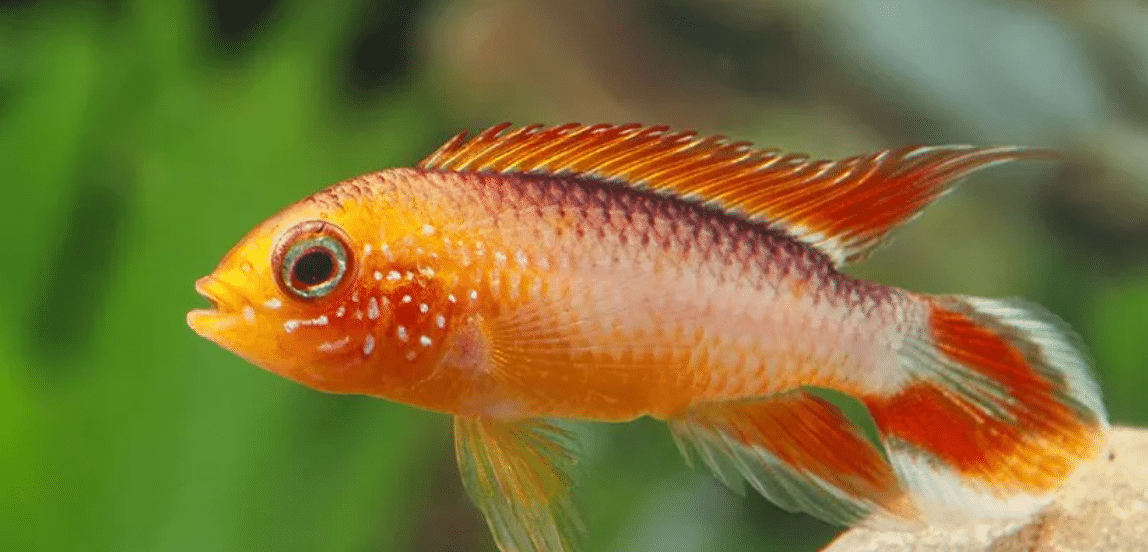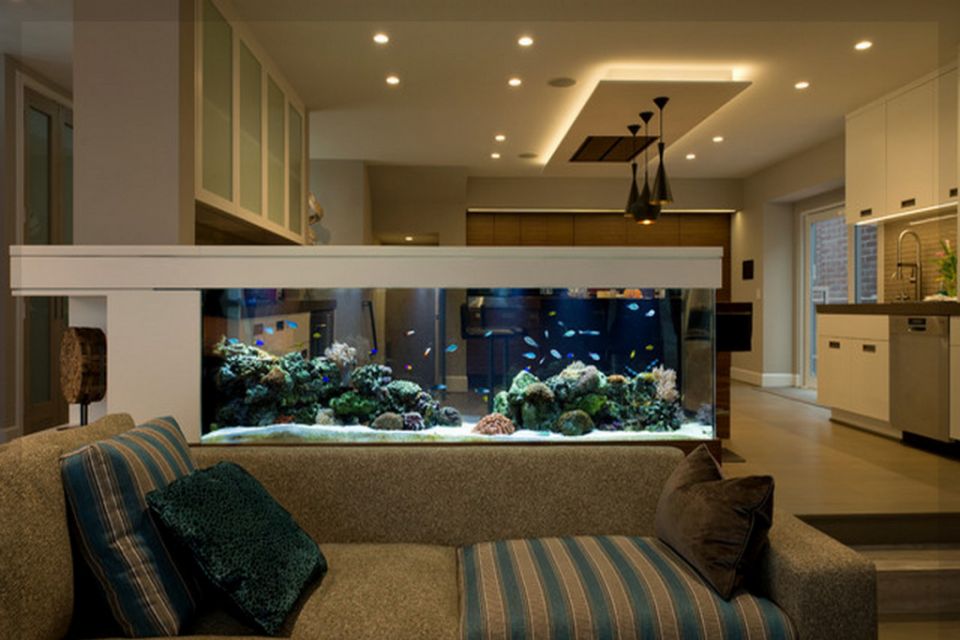Cockatoo cichlids in the aquarium or Apistogramma Cactuoides are a kind of South American dwarf cichlids, which are very popular in Germany. That is naturally not least due to the interesting behavior of the small Kakadu-Zwergbuntbarsche and its splendid coloring, that comes especially with the breed-form “double-red” to the validity. Although Apistogramma Cactuoides are relatively easy to maintain, they should rather be kept in larger aquariums thanks to a pronounced district formation and the preferred harem attitude.
The following guide will show you how to successfully keep cockatoo dwarf cichlids in your aquarium, which water values they prefer, what Apistogramma Cactuoides eat and how to breed them!
Table of Contents
Appearance, characteristics and other facts about Apistogramma
| little man | female | |
| Look: | Large dorsal and caudal fin with orange-red coloration | Light yellow shimmer – less gorgeous fins |
| Size: | 7-10 centimeters | Up to 6 centimeters |
| Dude: | 3-4 years | 3-4 years |
Cockatoo dwarf cichlids are available in many different breeding forms in almost all German pet shops. Especially often, however, the variant “double red” is available: with this breeding form, the clearly more splendid male is characterized by an orange-red dorsal fin and a tail fin of the same color. The elongated dorsal fin of the males has conspicuously large rays and, in combination with the colouring of the animals, brings a particularly beautiful effect to a South American tank. As so often with Apistogramma-Arten also with the Kakadu-Zwergbuntbarschen the females are clearly more inconspicuously and less splendidly colored than the males: the dorsal fin is much smaller and shimmers only slightly orange-red. The body is slightly yellowish in colour and has a black vertical bandage, just like the males. The animals grow quite large with a body length of up to 7-10 centimetres and are therefore not suitable for keeping in small aquariums. Like most South American Zwergcichliden, also the Kakadu-Zwergbuntbarsche don’t become very old: most animals fall out with an age of well 3-4 years. However, the animals are usually only sold at an age of 6 months to 1 year, which significantly reduces the lifespan in the aquarium once again.

The origin of the Kakadu dwarf cichlids
Apistogramma Cactuoides occur in waters of the Peruvian rainforest near shore zones. The waters are mostly very small, often regular ponds which are covered with a thick layer of falling leaves at the bottom and have a lot of dead wood. It is not uncommon for the waters to be slightly alkaline black water. However, the Apistogramma Cactuoides is quite rare in the wild and if then only found in the Peruvian rainforest – like many of the South American dwarf cichlids it has a very small distribution area.
What water values does Apistogramma Cactuoides need?
Kakadu-Zwergbuntbarsche place relatively high demands on the water quality, as it is usual for South American Apistogramma-Arten. Your aquarium water should at best be characterized by the following values:
| temperature | 23° – 28° C |
| pH | 5,5 – 7,6 |
| Total hardness (dGH) | 5° – 18° d |
Apistogramma Cactuoides feel particularly comfortable at a temperature of 23-28° Celsius. Combined with soft and slightly acidic water, optimal is a total hardness below 10 and a pH-value below 7, the home waters of the Kakadu cichlid are best represented.

How to keep Apistogramma Cactuoides in an aquarium?
Kakadu-Zwergbuntbarsche belong to the family of the South American Zwergcichliden. With a length of 7-10 centimetres, they do not remain exactly small and should therefore not be kept in aquariums that are too small.
Do you keep A. Cactuoides in pairs or harems?
Kakadu dwarf cichlids make no small demands on the water quality as already described above. At the same time, they are an aggressive-region-forming species that is optimally kept in harem conditions in the aquarium. Although it is often read on the Internet that cockatoo dwarf cichlids can also be kept in pairs, it is advisable to socialize a male with 2-3 females if you want to observe their natural courtship display behavior. The harem attitude and the district forming behaviour of Apistogramma Cactuoides means that the animals should not be kept in small aquariums such as the 54/60 litre tank. The aquarium should have a minimum size of 100 cm edge length, i.e. 180-240 litres tank volume.
Aquarium structure and tank design: how large must the aquarium be?
| Planting: | tight |
| Subsoil: | Fine-grained sand as dark as possible |
| Decoration: | Moorish wood roots, stones, caves, coconut shells, tubes |
Apistogramma Cactuoides are native to shore zones in the Peruvian rainforest. These shore zones are characterized by dense foliage and a lot of dead wood, as well as a dark ground. In order to simulate this habitat in an aquarium, cockatoo dwarf cichlids should be densely planted, have a dark, fine-grained bottom and plenty of deadwood, ideally bogwood roots. Just if one considers the harem attitude, the Zwergcichliden need this dense planting and the Moorkienholz as hiding-possibilities and for the precinct-formation the dwarf cichlids. An A. Cactuoides females need approx. 20 centimetres of basin radius as territory, while males can mark out a good 50-60 centimetres of the aquarium as territory. In smaller tanks, such as a 60 litre to 112 litre aquarium, edge length 60 to 80 centimetres, one can usually not provide enough hiding places than the keeping of cockatoo cichlids would be possible. Therefore, the attitude of the animals is recommended only from moderate-sized basins with an edge-length of 100 centimeters – that is usually 180-240 liters of aquariums. In such an aquarium, which has sufficient hiding places and precincts, one should socialize a cockatoo dwarf cichlid male with 2-3 females.
Apistogramma Cactuoides societies: Cockatoo cichlids and which fish?
Kakadu-Zwergbuntbarsche are a quarter-forming type South American Zwergcichliden as already described above. Just in the combination-time, the animals can become very aggressive opposite other basin-inhabitants. This effect is intensified if there are not enough hiding places in the aquarium or if species are kept in the aquarium which do not respect the territories of the animals – e.g. armored catfish. In addition, male Apistogramma Cactuoides with a maximum body length of 7-10 centimetres become quite large in adult animals, which is why one should not associate too small species with the cockatoo cichlids. A swarm of South American tetras, such as red neon, blood tetras or ornamental tetras, is suitable as an optimal side stock for A. Cactuoides. One should do without species, which like the Kakadu-Zwergbuntbarsche inhabit the ground and could penetrate into the precincts of the animals: only in this way one can observe the behavior of the animals particularly well and also celebrate breeding successes. You’ll find many more suggestions for your aquarium in our great guidebook
What does the Apistogramma Cactuoides eat?
Like most South American dwarf cichlids, the A. Cactuoides is a greedy carnivore. Although the animals can also be fed with regular aquarium flake food, cockatoo cichlids should be provided with food for life or frost at regular intervals. This does not only contribute to the well-being of the animals, but also provides for a clear more splendid colouring. The following frost food is eaten by you particularly gladly:
How many Apistogramma Cactuoides can you keep in the aquarium?
As already mentioned above, the rather territorial cockatoo cichlids are not suitable for small aquariums. Instead, the posture of the popular dwarf cichlids should only be considered from an edge length of 100 centimetres. Not only can you carry out the harem keeping, which the males prefer, but also the natural behaviour of the animals can be observed much better. If one is lucky and has a tank that is big enough, one can even socialize several males of Apistogramma Cactuoides with several females and observe the full courtship behavior. Below you will find an overview of how many cockatoo dwarf cichlids you can keep in different tank sizes. Please note that the amount of animals depends very much on the pelvic structure of your aquarium and the accompanying stock:
| basin size | Apistogramma Cactuoides Male | Apistogramma Cactuoides female |
| 180 litres (100 centimetres) | 1 | 2 |
| 240 litres (120 centimetres) | 1 | 2-3 |
| 350-450 litres (150 centimetres) | 1-2 | 2-4 |
| 700 litres + (200 centimetres +) | 2-3 | 3-6 |
How do you breed cockatoo cichlids?
It is not difficult to breed Apistogramma Cactuoides. First of all one should do without species in the aquarium, which could penetrate into the precincts of the animals, as already mentioned above. Together with the optimal water-values, that are to be seen above, as well as some caves, the breeding succeeds even in the society-aquarium. In general, Apistogramma Cactuoides also reproduce in pairs, but the chance of offspring is significantly increased if the “reproductive carriers” males are socialized with several females. In the case of the reproduction, both parents operate the careful brood-care. Usually one of the animals guards the offspring, while the other parent defends the territory. The offspring of the Kakadu-Zwergbuntbarsche should be fed initially with particularly small live food: Artemia nauplii are particularly suitable for this.

Which breeding forms of Apistogramma Cactuoides are available on the market?
Like most popular cichlids, A. Cactuoides are also available in Germany in several different variants which differ optically but have the same behaviour patterns. The following species are available in most zoo shops:
- Double red and triple red: back and tail fins shimmer orange-red with black accents
- Orange Flash: complete orange-red tail and dorsal fin

The Kakadu-Zwergbuntbarsch is a demanding aquarium dweller that above all attaches great importance to the water quality and thanks to its territoriality can also become aggressive towards other species, but this is almost always the case with South American dwarf cichlids. If you get to know the species a little, inform yourself beforehand and choose the right aquarium stock, you will also be happy with the Apistogramma Cactuoides. However, it is important that you have a medium sized aquarium – at least 100 centimeters edge length it should have. In addition, one must offer some hiding places to the animals, like roots and stones and a quite dense planting, so that the Kakadu-Zwergbuntbarsch can mark out its precinct. The attitude should take place in harem-attitude: at best 1 male on 2-3 females. A swarm of South American tetra, such as red neon, which also comes from Peruvian rainforest waters, is suitable for socializing.
The most important facts are summarized below



